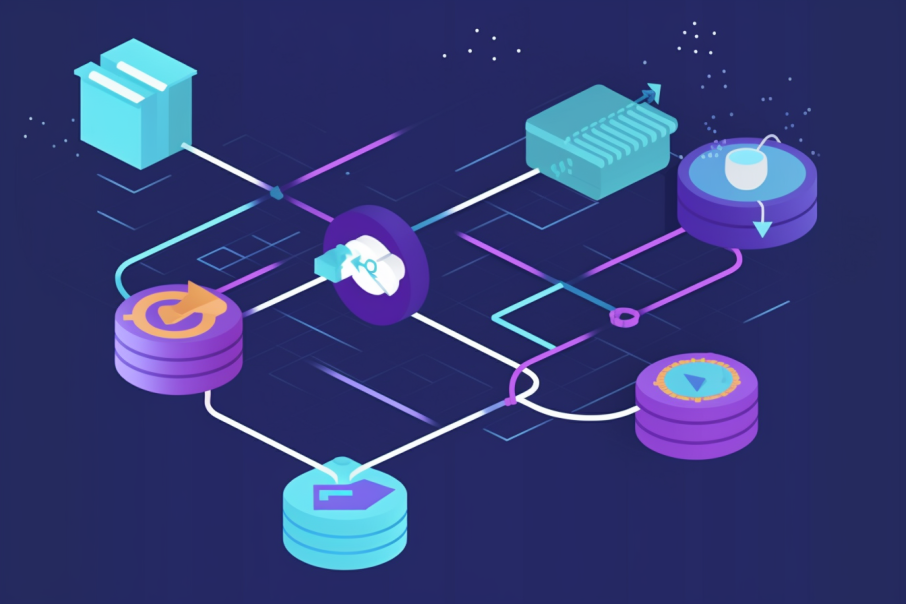
Transform Your Data Integration with Powerful ETL Tools
Do you need to empower your data integration strategy? In this article, we’ll explore the various ETL tools available for connecting Salesforce, Power BI, and a few more.
You don’t need any prior knowledge of coding or programming. With enough effort, you’ll soon be well on your way to mastering these powerful tools and unlocking their full potential.
So, let’s get started!
Reverse ETL Tools
There are a variety of ETL tools available that can help you empower your data integration strategy. These solutions enable businesses to quickly move their data from one platform to another with ease. Moreover, they all offer advantages in terms of automating processes and improving the accuracy of data transfer between systems.
With reverse ETL tools, companies can ensure their customer information remains protected during migration.
Streaming ETL
The term “Streaming ETL” refers to the real-time movement and processing of data from one location to another. ETL stands for Extract, Transform, and Load, which are functions commonly used in databases.
Real-time applications such as fraud detection, the Internet of Things, edge computing, streaming analytics, and real-time payment processing rely on streaming ETL. One instance where streaming ETL is useful is in creating a “360-degree customer view”. It improves real-time communication between the business and the customer.
Finding the right fit should be relatively painless — so let’s move on now and take a look at Tableau ETL!
Tableau ETL
Tableau has made data gathering easier and more diverse, which allows for the integration of more data sources. With more dynamic data, the possibility of discovering new insights increases, leading to more detailed answers on unexplored aspects.
The Tableau ETL Integration feature enables you to swiftly and effortlessly combine data from different databases and tables. This provides you with a competitive advantage by enabling the analysis of data regardless of its location.
GET IN TOUCH
We’ll Take Care of Your ETL Needs
Big Data ETL
Big data ETL empowers any data integration strategy. It allows managing, cleansing, and transforming large amounts of data quickly and efficiently. The right big data ETL solution can provide valuable business insights. It also streamlines processes related to customer service and product development.
From cloud-based to open-source Python ETL tools, there are various types of big data ETL solutions available today:
- Data Lake ETL: Extracts, transforms, and loads (ETL) datasets for analytics in a cloud platform like AWS/Azure/GCP. It allows for storing massive volumes of data on demand with no upfront costs. This provides the ability to gain deeper insights into customer behavior and trends.
- Cloud ETL: Leverages cloud computing infrastructure for cost-effective storage & processing power needed for advanced analytics operations. It minimizes operational overhead associated with managing large datasets and provides scalability without needing additional hardware investments.
- Python ETL: Open source libraries used to develop custom scripts using Python language code. You can build reliable pipelines capable of handling diverse tasks like extracting, transforming & loading different sources of data together. It enables teams to create bespoke applications suited to their specific requirements. It offers flexibility in designing complex workflows as well as simpler ones.
- Data Quality ETL: Utilizes sophisticated algorithms which detect anomalies in incoming raw datasets by running tests against preconfigured rules. It ensures the accuracy and consistency of the records stored within enterprise systems. It eliminates errors caused due to manual entry mistakes or missing information fields during the transfer process.
- Data Warehouse ETL: Transfers historical datasets from multiple sources onto centralized platforms like Amazon Redshift. It enhances visibility across the organization’s internal workings through a consolidated view. This accelerates the decision-making process with updated reports generated faster than ever before.
PostgreSQL ETL
If your business wants to use the large volumes of data stored in PostgreSQL, they need to integrate it with other systems. PostgreSQL ETL tools can help with this. ETL tools extract data from PostgreSQL databases, transform it into a format that’s suitable for analysis, and load it into a target system. This process can be automated, which saves time and reduces errors, improving the efficiency and accuracy of data integration efforts. PostgreSQL is a popular open-source relational database management system.
There are various ETL tools that work well for integrating PostgreSQL data, and one of them is Talend. It comes with a user-friendly interface that allows users to create and run data integration workflows. Additionally, it supports PostgreSQL and many other data sources.
Apache Nifi and AWS Glue are two different data integration tools with different features. Apache Nifi is an open-source platform that can handle complex data integration projects with its data routing, transformation, and mediation capabilities. On the other hand, AWS Glue is a cloud-based ETL service that supports PostgreSQL and other data sources. By using a PostgreSQL ETL tool, businesses can integrate their data, improve data quality, and gain valuable insights to drive growth.
Power BI ETL
Power BI is a tool for business intelligence that includes ETL as one of its functions.
To clarify, ETL stands for Extract, Transform, Load, which is a data pipeline organizations use to integrate different data sources. Without ETL, analytical reports and dashboards may have outdated data, making them look old. ETL helps to update the data so that the reports remain current.
Power BI is a set of software tools, applications, and connectors. It transforms your disparate data sources into cohesive, visually-rich, and interactive insights.
The part that we can all see is the visually immersive and interactive insights, which is one of the outputs from a collection of services, apps, and connectors. ETL is included in this collection of tools.
Power BI combines an ETL tool with data modeling and visualization capabilities, making it an ideal tool for data analysis. The ETL component ensures data coherence, while the modeling and visualization features enhance the analysis experience.
Here are the Power BI ETL capabilities:
- This software has the ability to establish connections with different data sources and retrieve relevant data.
- A visual editor that enables a wide range of data transformations, including sorting, grouping, and splitting columns, among others.
- The M language is used for writing any transformations that are done visually. Additionally, the code can be edited through the Advanced Editor.
- Use Azure Machine Learning and Cognitive Services to generate AI insights.
Domo ETL
Domo ETL is a useful tool for automating ETL processes and improving scalability and optimization in organizations’ data integration efforts. With its advanced architecture, Domo allows users to create custom pipelines quickly and easily.
According to recent studies, the use of Domo has increased by an astonishing 40% in just one year! Thus, it’s a great choice for business owners looking for efficient and cost-effective ways to integrate and manage their data.
With its flexibility and user-friendly interface, this platform can be used even by non-technical personnel. All these benefits make Domo an essential tool for any organization wishing to empower its data integration strategy.
Ipaas Vs. ETL
Both iPaaS (Integration Platform as a Service) and ETL (Extract, Transform, Load) are technologies used for moving and processing data between different systems. But they have unique features and serve different purposes.
iPaaS
- Cloud-based:iPaaS is a platform for integration in the cloud. It offers tools and services for connecting and managing data across various cloud and on-premises applications.
- Application integration: iPaaS is aimed at integrating different software applications, regardless of whether they are SaaS or on-premises applications, specifically for application integration purposes.
- Scalability: iPaaS solutions are designed to easily handle growing amounts of data and integrations by using cloud technology to scale up.
- Agility: iPaaS is recognized for its ability to be agile and flexible, allowing businesses to swiftly adjust to changes in integration needs.
- Real-time processing: Many iPaaS solutions can process data in real time, providing instant insights and enabling prompt actions.
ETL
- Data warehousing: ETL is a process of gathering data from different sources, modifying it to match a standard format, and storing it in a central repository for future analysis. The primary use of ETL is in data warehousing.
- Batch processing: Data is usually gathered, modified, and imported on a preset schedule, meaning that ETL processes are performed in batches.
- Data transformation: Data transformation is a major focus in ETL, which involves transforming data through processes like data cleansing, validation, enrichment, and aggregation.
- On-premises or cloud: ETL can be done either on-premises or in the cloud. While traditional ETL solutions are mostly on-premises, nowadays, numerous modern ETL tools provide cloud-based alternatives.
- Less flexible: iPaaS solutions offer more flexibility than ETL processes as they can adapt to various data integration tasks. ETL processes, on the other hand, are for specific tasks and can be challenging to modify.
To put it briefly, iPaaS is a cloud platform that focuses on instantly integrating applications, whereas ETL is a data processing method primarily used for data warehousing and batch processing. The decision to opt for either iPaaS or ETL depends on your individual data integration requirements, the kind of applications and systems you are dealing with, and the level of adaptability and scalability that you desire.
Metadata Driven ETL
Understanding the power of ETL automation is key to any data integration strategy. From Salesforce to Power BI and beyond, it’s important to get a grip on the best practices for cloud-based ETL solutions, data lake ETL pipelines, and traditional data warehousing ETL.
Some tools are more specialized than others; however, all have their place in modern data engineering landscapes. Through an understanding of how different components fit together within your chosen approach, you can create powerful yet maintainable systems that meet your needs now and in the future.
Mulesoft ETL
This platform, based on the cloud, allows organizations to create ETL pipelines for data warehousing and other purposes. You can use it to build ETL jobs quickly and easily, which move large amounts of data from source to target without requiring complex code.
If you prefer greater control over your ETL workflows, you have the option to use the drag-and-drop interface or the Data Build Tool (DBT).
One advantage of using Mulesoft is that you do not have to possess any coding background. In other words, no programming skills are needed!
Now that we’ve talked about using Mulesoft to create your own ETL process let’s move on to the topic of no-code ETL.
No Code ETL
No-code ETL tools are becoming increasingly popular as they allow users to build powerful data pipelines with little effort. These cloud-based, open-source solutions give developers the ability to quickly set up large-scale and real-time ETL processes without writing any code. That means you can start transforming your data almost immediately – no coding skills are required!
This efficiency makes it easier for businesses to keep their data up to date so that decision-makers always have access to the latest insights. With no code ETL, there’s really no limit on how far you can take your data integration strategy – from salesforce all the way to Power BI and beyond.
Salesforce ETL Tools
Have you ever wondered how businesses are able to extract, transform and load their valuable data from cloud-based applications such as Salesforce into a Data Warehouse or Data Lake for further analysis? With the right ETL tools, it’s easier than ever!
Cloud ETL technologies enable businesses to quickly gain insights from their data by combining data sources in real time. This helps them make more informed decisions about their business strategies and uncover new opportunities for growth.
With Business Intelligence (BI) solutions like Power BI providing powerful visualizations of your information, understanding trends has become much simpler. Making use of these modern ETL tools can be incredibly beneficial to any organization looking to enhance its data integration strategy.
SAS ETL
With SAS, you can unlock the power of data integration. You can also leverage its capabilities for everything from cloud-based ETL to testing and pipeline architecture. By deploying a modernized data lake strategy with an efficient SAS ETL system, you can maximize performance while minimizing effort.
This includes faster extraction speeds, better scalability options, and more secure storage solutions. As well as being able to access insights in real-time, it also allows increased visibility into your data sources so that you have greater control over how they are used.
Moving forward without needing to rely on manual processes or complex coding languages gives you the freedom to be agile when needed. From there, take advantage of automated tasks such as scheduling jobs and monitoring changes – allowing you to make smarter business decisions quickly.
Singer ETL
Life can be a lot easier when it comes to data integration, especially with the help of ETL tools. Singer automation is one such tool that helps streamline the process by enabling cloud ETL and automating tedious tasks like data validation or building complex ETL architectures.
With its ability to quickly connect disparate systems and validate data in near real-time, Singer makes integrating large datasets much simpler than before! This means fewer headaches for you as you no longer have to worry about managing your ETL processes manually.
Instead, you’ll be able to focus on what really matters: making sure your business gets the most out of its data migration efforts. Now let’s take a closer look at how Singer can help make this happen.
Data Migration ETL
To have a successful data strategy, it’s crucial to integrate data properly. Using ETL tools such as Salesforce and Power BI can help keep your data organized.
These tools can assist with tasks such as transferring large datasets to cloud-based systems and developing customized models to improve organization. By using an ETL tool, you can efficiently transfer, modify, and store large volumes of data. Additionally, it is possible to create data lakes that are more accessible and user-friendly.
Data engineering also becomes simpler thanks to these powerful solutions – it’s no wonder they have become so popular among businesses looking for more effective ways to manage their data needs.
As we look at how Domo Magic ETL can further improve our approach here, let’s keep this efficiency in mind.
Domo Magic ETL
Domo Magic ETL can empower your data integration strategy like no other. It provides the flexibility of Data Vaulting, Event-Driven automation, and Cloud Migration capabilities so you can sync data in real time for better analytics.
With Domo Magic ETL, you don’t have to worry about complicated manual processes as it automates what used to be a tedious task. And with its intuitive interface, you are able to quickly view performance metrics related to your data migration initiatives without having to write any code at all.
Plus, since it’s cloud-based, there is no need to install anything on-premise – giving you total freedom from hardware constraints. This makes Domo Magic ETL an ideal choice for organizations looking for a robust solution that helps streamline their data integration efforts while providing them with accurate insights into their business operations.
ETL Data Migration
Let’s discuss the next step in our data integration plan, which is ETL Data Migration, after covering the capabilities of Domo Magic ETL in connecting Salesforce with Power BI.
Businesses aiming for a comprehensive approach to their data warehousing needs must utilize cloud computing, given the extent of this kind of transformation. Real-time ETL solutions help organizations synchronize their databases to maintain consistent data across multiple systems. Additionally, these tools are invaluable when it comes to migrating large amounts of data from one system or application into another quickly and safely.
ETL Tools For Data Migration
As the old adage goes, “a stitch in time saves nine.” Investing in a robust data integration strategy now can save countless headaches (and dollars, too!) down the road.
With this goal in mind, consider leveraging ETL tools to help power your data migration efforts and bring all of your disparate sources into one cohesive platform. This could include everything from loading Salesforce databases into Data Lakes or implementing SQL Server for data governance purposes. You’ll be able to leverage machine learning and real-time analytics capabilities as you go, ensuring that you get the most out of your investments.
With an optimized ETL process in place, tracking progress will become simpler than ever before – giving you ultimate control over every aspect of migrating your organization’s data.
ETL Tracking
Tracking is essential when it comes to data governance, modernization strategies, and automated testing. It allows you to monitor the flow of information from source systems into target databases or applications with data quality assurance and error-handling capabilities. This helps ensure the accuracy and integrity of your data as it passes through different transformations in the ETL cycle.
Organizations can have more confidence and less worry by implementing thorough tracking processes, which verify that their data pipelines are functioning properly.
Conclusion
ETL tools help businesses in managing their data. They also streamline processes by integrating different tools effectively, making them a powerful option for data integration strategies.
There are various ETL solutions available for businesses, including those that can be used for Salesforce and Power BI. What makes this technology so effective? Over 72% of companies using ETL solutions reported increases in both efficiency and accuracy when dealing with large datasets.
This highlights just how much time and money businesses can save by leveraging these technologies correctly. Thus, investing in the right ETL tools can deliver huge benefits for any organization striving to optimize its data management process.
As our world continues to become increasingly digitalized, having access to such advanced technologies will only become more essential. Because of this, now is the perfect time to empower your data integration strategy!
GET IN TOUCH
Work with Reputable ETL Experts

